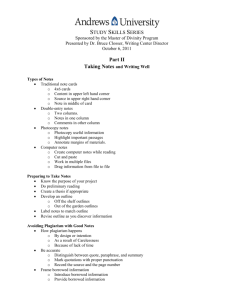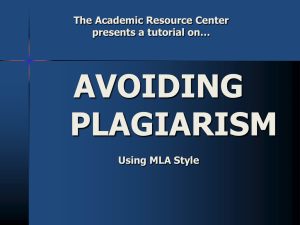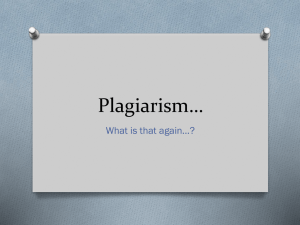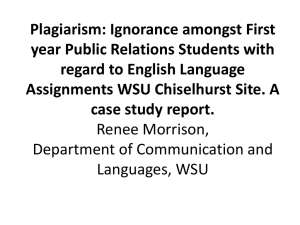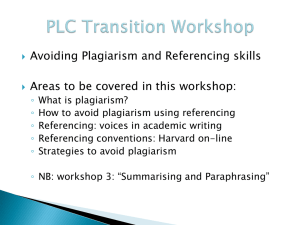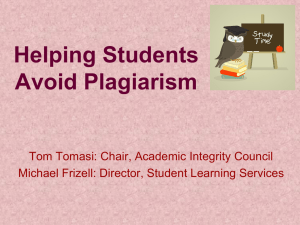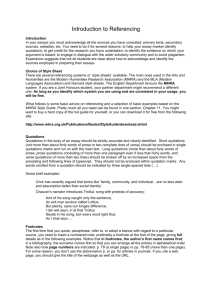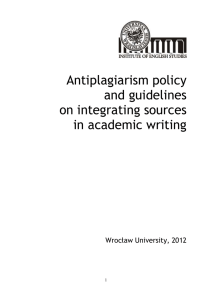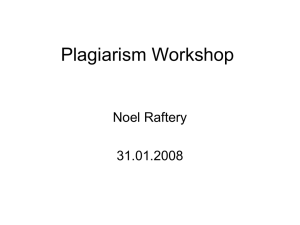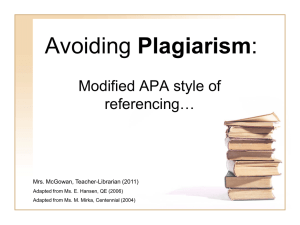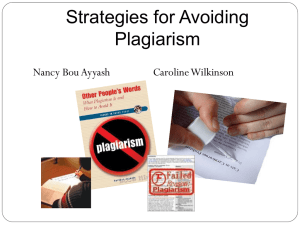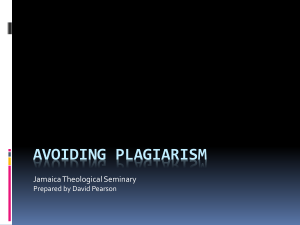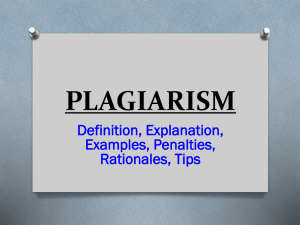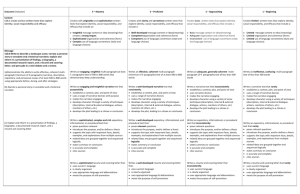Plagiarism and Citing Sources
advertisement
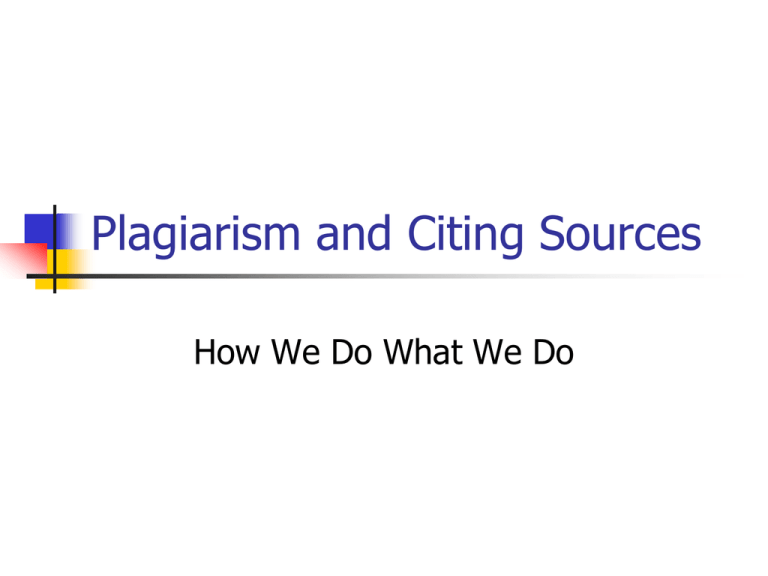
Plagiarism and Citing Sources How We Do What We Do UF Honor Code . "On my honor, I have neither given nor received unauthorized aid in doing this assignment." Plagiarism—Plagiarism.org “A study by The Center for Academic Integrity found that almost 80% of college students admit to cheating at least once.“ “According to a survey by the Psychological Record 36% of undergraduates have admitted to plagiarizing written material.” What is Plagiarism? 1. “Handing in someone else’s work—a downloaded paper from the Internet or one borrowed from a friend—and claiming that it’s your own.” 2. “Using information or ideas that are not common knowledge from any source or failing to acknowledge that source.” What is Plagiarism? 3. “Handing in the same paper for two different classes.” 4. “Using the exact language or expressions of a source and not indicating through quotation marks and citation that the language is borrowed.” What is Plagiarism? 5. “Rewriting a passage from a source by minor substitutions of different words but retaining the same syntax and structure of the original.” The Common Knowledge Exception While you always have to tell readers what information you have borrowed and where it came from, things that are “common knowledge” are excluded from this. Everyone knows, for example, that John Kennedy dies in Dallas in 1963. This and other widely known facts need not be cited. Avoiding Plagiarism It’s fine to borrow distinctive terms or phrases from a source, but also signal that you’ve done so with quotation marks. Always cite borrowed material. Avoiding Plagiarism Make a habit of using attribution tags, signaling to your reader who is the source of the idea, quotation, or fact. These tags include things such as, Tannen argues, Tannen writes, According to Tannen. Why Cite? Like a tree, knowledge in a discipline is a living thing, from time to time losing and adding branches, growing in new directions. One whose limbs am I standing? Who has helped me to see? Paraphrasing Try to say something in your own words—keep it about the same length as the original. Demands you make sense of something—reread until you understand what the author is saying. Good writers find their own way of saying things. Paraphrase Practice “For most of the last 500 years, imitation was the sincerest form of architectural flattery.” “Houseflies not only defecate constantly, but do so in liquid form, which means they are in constant danger of dehydration.” Summarizing Summarizing is a reduction of longer material into some brief statement that captures a basic idea, argument, or theme from the original. Don’t misrepresent the general thrust of the author’s ideas! Ask, does my selective use of this source give it a spin the author didn’t intend? Quoting General Rule: The college research paper should contain no more than 10 or 20% quoted material. When to Quote Distinctive phrasing—when restating the thought wouldn’t possibly do it justice. When the person is an expert in the field—adds credit to your argument. The explanation of a process or an idea is especially clear. Quoting Fairly 1. Quote accurately. 2. Make sure it’s clear in your notes that what you’re jotting down is quoted material. 3. Beware of distorting a quote by using it out of context. Note Taking Tips 1. Look for ways to connect what you already know with what you are reading. 2. Combine two modes of thought, two processes: collecting and focusing, observations of and ideas about, getting down and opening up. Note Taking Tips 3. Mark up your copies of the sources: underline, annotate, draw lines and arrows. 4. Imagine that your notes are a conversation with the author. Four Motives for Using a Source 1. Sources can extend your thinking. 2. Sources can provide necessary background. 3. Sources can support or exemplify a point you want to make. 4. Sources can present opportunities for analysis and interpretation. Narrative Note Taking First Layer: Story the Source Read from beginning to end, marking up your personal copy with underlining, marginal notes, highlighter. Then tell the story of the text— chronological account. Narrative Note Taking Second Layer: Rapid Summary Reread—but selectively. Look for things that seem to be repeated or seem to be important assertions, claims, or findings. Now write a few sentences that summarize your understanding of what the source is saying about your topic. Narrative Note Taking Third Layer: Narrative of Thought Push the text aside and reflect: Before I started reading this article/book/Web document/etc., I thought__________, but now I understand that_____________. That makes me think _____________. Introducing Quotations X states ………….. As the prominent philosopher X puts it, “…..” According to X, “…….” X himself writes, “……..” In her book, ………, X maintains that “………” Capturing Authorial Action X X X X X X X acknowledges that…… agrees that….. argues that……. believes that……… claims that….. insists that……. questions whether……. Introducing Quotations Writing in the journal Commentary, X complains that “……” In X’s view, “…………..” X agrees when she writes, “…………” X complicates matters further when he writes, “………..” X disagrees when he writes, “……..” Explaining Quotations Basically, X is saying……….. In other words, X believes…… In making this comment, X argues that……. X is insisting that…………… X’s point is that…………….. The essence of X’s argument is that…. How Not to Introduce Quotes Both of the following are redundant and misleading: X asserts an idea that…… (redundant) A quote by X says…….(misleading…it is the writer doing the quotation. Ballenger, Bruce. The Curious Researcher. 5th ed. New York: Pearson, 2007.


